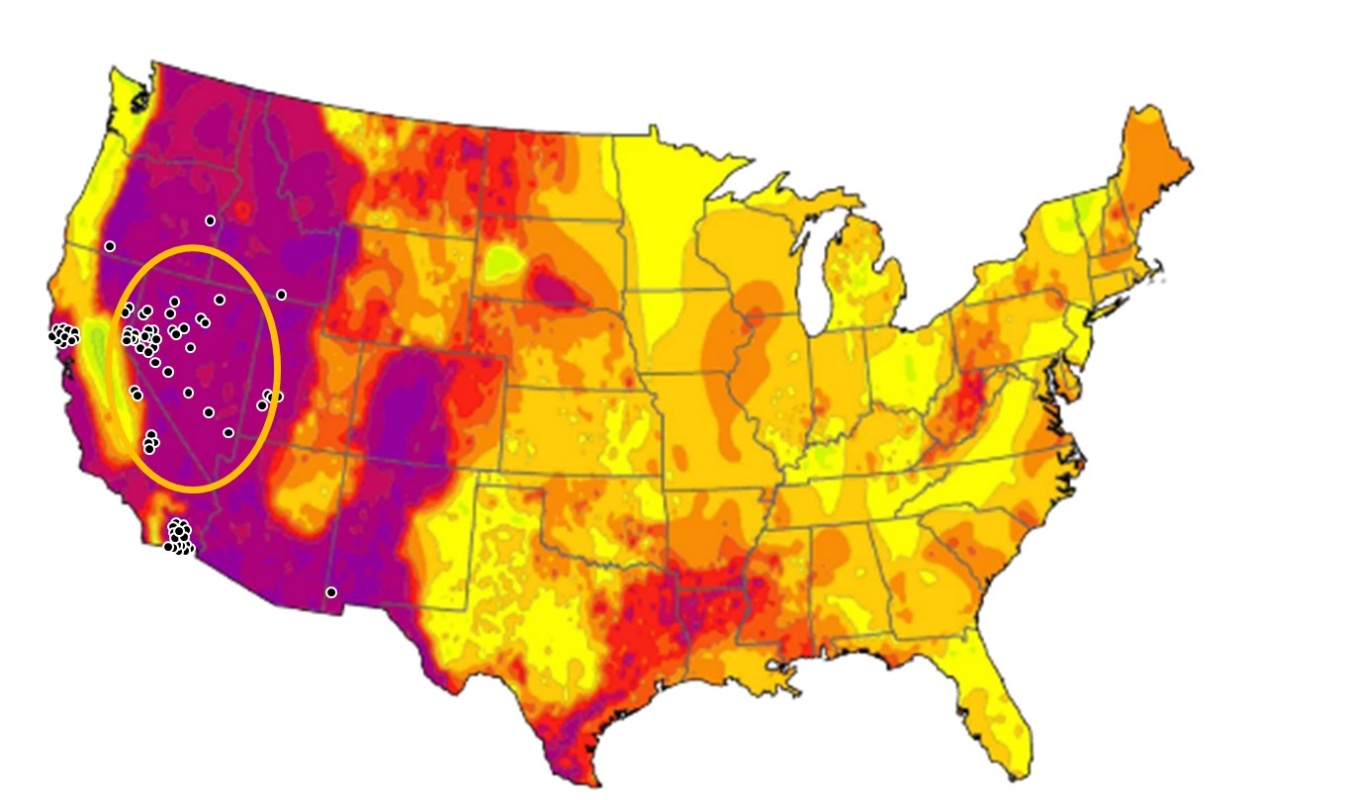Researchers estimate that 25 GWe of undiscovered hydrothermal resources exist in the contiguous United States, representing a vast untapped source of domestic geothermal energy potential.
Geothermal Technologies Office
March 22, 2021Geothermal Industry Seeks Data
Researchers estimate that 25 GWe of undiscovered hydrothermal resources exist in the contiguous United States[i][ii], representing a vast untapped source of domestic geothermal energy potential. Existing geophysical techniques, however, cannot reliably detect these systems or image them with a high degree of confidence. Finding new ways to explore for undiscovered geothermal resources can improve the success rate of geothermal development projects and reduce overall exploration costs—charting the course towards millions of good-paying union jobs, and the guarantee that its benefits will reach every American community.
Perhaps looking to geothermal-adjacent industries could help. Geothermal systems and mines, for example, have a lot in common. They’re both underground and exist because of an unlikely chain of events over many millions of years. The two industries use similar technologies (e.g. subsurface imaging and drilling) and data (e.g. geochemistry, geology) to unlock their assets. In fact, numerous geothermal systems have been unintentionally discovered through mining exploration and many successful geothermal power plants were established directly atop or in the vicinity of inactive mining operations. And the mining industry in recent years has begun evaluating geothermal as a source of onsite power.
Mining Industry Seeks Green Power Production
The U.S. mining industry seeks practices and improved environmental performance while also needing to cost effectively power remote mining operations[ii].
Geothermal systems can offer on-site electricity with a low carbon footprint, provided the source can be located and explored cheaply with existing data. Onsite geothermal resource development could not only provide on-site electricity at reduced costs, but also offset mine permitting and development costs while offering environmental benefits that can address corporate targets.
Who Will Help These Two Out?
The Geothermal Technologies Office (GTO) funded the Geothermal Opportunities Leveraged through Data (GOLD) research project at NREL to assess potential connections between the geothermal and mining industries. In the end, GTO would like to increase discovery of undiscovered hydrothermal resources using the ample existing mining industry data while helping the mining industry achieve its environmental goals[ii].
Under the GOLD project, NREL performed three case studies on three geothermal electricity-generating facilities in Nevada identified through mining activities: McGinness Hills, Blue Mountain, and Don A. Campbell power plants. NREL collected, reviewed, and analyzed public and private mining data, resource exploration costs, existing infrastructure (e.g., transmission lines), and regulatory factors on private and BLM lands.
NREL researchers further assessed links between the mining and geothermal industries, confirming that mining industry data could increase the rate of discovery of geothermal resources and decrease costs associated with geothermal resource discovery. The research also established that the mining industry could catalogue and monetize geothermal resource data and use those data to develop geothermal electricity to power mining operations at lower costs.
NREL’s results demonstrate a strong case for the future collaboration between the mining and geothermal industries. Much of the data collected by the mining industry as part of its mineral exploration could identify previously unknown geothermal resources. Most of the data is collected by drilling wells, and the mining industry drills a lot of wells. For example, the mining industry in 2017 drilled more than 2,000 exploration holes in Nevada, compared to the geothermal industry’s 31. Overall, leveraging mining data to discover geothermal resources results in geothermal’s levelized cost of energy (LCOE) to be reduced by 23%–29% . Similarly, mining companies, many currently paying $109–$185/MWh for onsite power generation from diesel generators, would benefit from a relatively cheap on-site geothermal power source which is reliable, flexible, and most importantly, green.
GTO is proud to say that, with confidence, the geothermal and mining industries make a great team, and are bringing out the best in each other.
The western U.S. is an active region for both the geothermal and mining industries. The areas shaded purple indicate highest-temperature geothermal resources, with active geothermal power plants shown as dots. This area encompasses the state of Nevada and overlaps a significant number of current and recent mining operations (circled).
Image adapted from Cladouhos (2018) and Blackwell (2011).
[i] Augustine, C.; Ho, J.; Blair, N. (2019). GeoVision Analysis Supporting Task Force Report: Electric Sector Potential to Penetration. NREL/TP-6A20-71833. Golden, CO: National Renewable Energy Laboratory. https://www.nrel.gov/docs/fy19osti/71833.pdf.
[ii] Williams, C.; Reed, M.; Mariner, R. (2008). A Review of Methods Applied by the U.S. Geological Survey in the Assessment of Identified Geothermal Resources. 2008-1296. Reston, VA: U.S. Geological Survey. Accessed June 20, 2018: https://pubs.usgs.gov/of/2008/1296/pdf/of2008-1296.pdf


